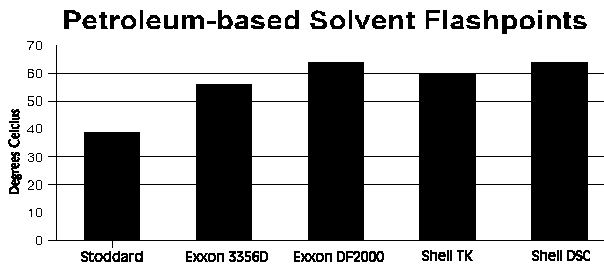Control of Fire Hazards in Commercial Drycleaning Shops Using Petroleum-Based Solvents
1997
DHHS (NIOSH) Publication Number 97-159
Hazard
Drycleaning shops contain all elements necessary for uncontrolled fires: fuels, ignition sources, and oxygen. Potential combustible materials include furniture, garments, lint, and portions of the building. The greatest risk of fire and explosion exists if the drycleaning shop uses a petroleum-based solvent in drycleaning machines. Approximately 10% of drycleaning shops in the United States use these highly flammable solvents. Ignition can be triggered by a burning or smoldering cigarette, heated equipment such as a press, a frictional spark inside the solvent reclaimer cage, or even static electricity within the reclaimer.
Controls
New solvents and machines are available today that are inherently safer than traditional petroleum-based solvents. All shops should follow fire codes and standards that address occupancy limits, building egress, and appropriate fire extinguishers, smoke detectors, fire suppression systems, and related issues to reduce the risk of fire. Code compliance will reduce the risk of loss from fire, and may also reduce property insurance premiums. In some cases, fire codes may not be as stringent with new solvents and machines.
New Solvents/Machines
- New petroleum-based solvents with higher flashpoints (above 55°C/131°F) have recently been developed (Figure 1). These solvents are less likely to ignite or explode than solvents with lower flashpoints.
- New, much safer petroleum-based drycleaning machines are also available. Several machine technical advances have been developed to reduce greatly the risk of fire and explosion. These advances include using a vacuum technology, an inert gas such as nitrogen, or controlling the operating parameters of the machine to prevent fire or explosion.
Building Features
- Enforce a “No Smoking” policy that eliminates smoking within the building. Post “No Smoking” signs.
- Provide shops with at least two remote means of escape in the event of a fire. Also provide drycleaning rooms with two remote means of escape. Keep fire exits and exit routes free and clear of clutter.
- Separate the drycleaning room from the rest of the building by a partition with a 2-hour fire resistance rating.
- Construct the floors and ceiling of the drycleaning room of fire-resistant material.
- Equip drycleaning rooms containing petroleum-based solvents with an emergency drainage system that directs solvent leaks and fire protection water to a safe location.
Fire Safety Systems
- Install an approved wet-pipe sprinkler system in the drycleaning room of any shop using petroleum-based drycleaning solvents. Automatic sprinkler systems are effective in preventing loss of life and controlling the spread of fire.
- Provide at least two approved 10-BC portable fire extinguishers inside a drycleaning room where petroleum-based solvents are used. Provide suitable portable fire extinguishers throughout the shop according to appropriate codes.
- Perform routine maintenance to prevent accumulation of fluff, lint, or waste that could ignite or cause a fire to spread rapidly.
Handling Combustible Liquids
- Install drycleaning rooms and tank storage rooms on the lowest floor above grade.
- Close all containers with flammable or combustible petroleum-based solvents to prevent evaporation. Do not transport petroleum-based solvents in open containers, rather, pump solvents through rigid iron or steel pipes to prevent ignition.
- Give special attention to generation and accumulation of static electricity. If garments are transferred from a washer using petroleum-based solvents to a dryer, bond together electrically and ground equipment.

Figure 1. Flashpoints of Stoddard solvent and four of the recently developed petroleum-based drycleaning solvents (with higher flashpoints).
A NIOSH technical report, Control of Health and Safety Hazards in Commercial Drycleaners: Chemical Exposures, Fire Hazards, and Ergonomic Risk Factors, has been published on this subject. This document is one in a series of seven HAZARD CONTROLS concerning control of hazards in the drycleaning industry that are available free upon request.
*NIOSH is the Federal agency responsible for conducting research and making recommendations for preventing work-related illnesses and injuries. All HAZARD CONTROLS are based on research studies that show how worker exposures to hazardous agents or activities can be significantly reduced.
Acknowledgments
The principal contributors to this publication are Gary S. Earnest, Lynda Ewers, Avima Ruder, Linda Goldenhar, Rosmarie T. Hagedorn, Jerome P. Flesch.
This document is in the public domain and may be freely copied or reprinted. NIOSH encourages all readers of this HAZARD CONTROLS to make it available to all interested employers and workers.
Control of Fire Hazards in Commercial Drycleaning Shops Using Petroleum-Based Solvents [PDF – 89 KB]
